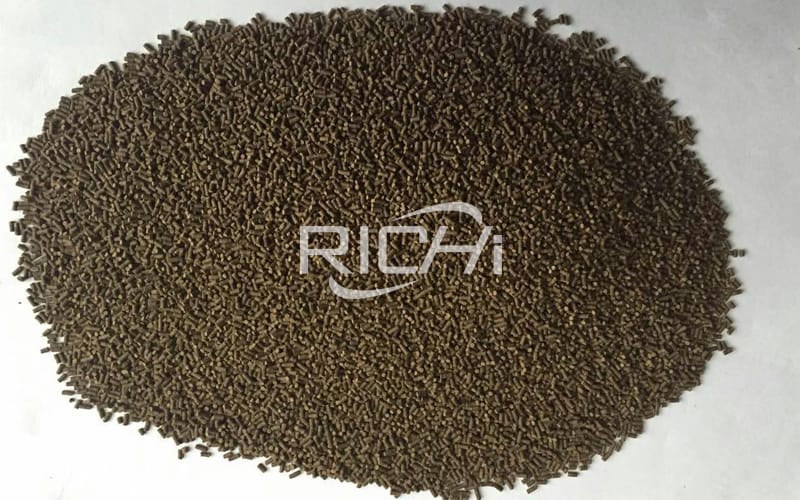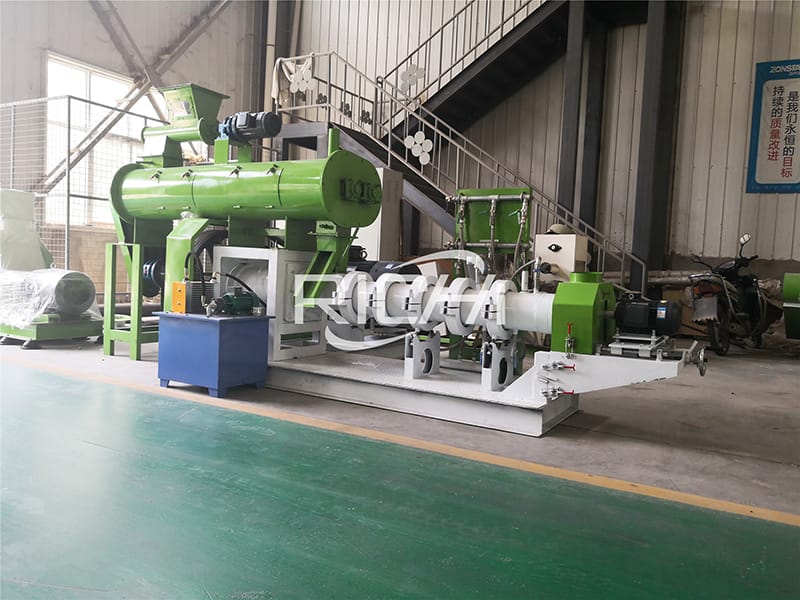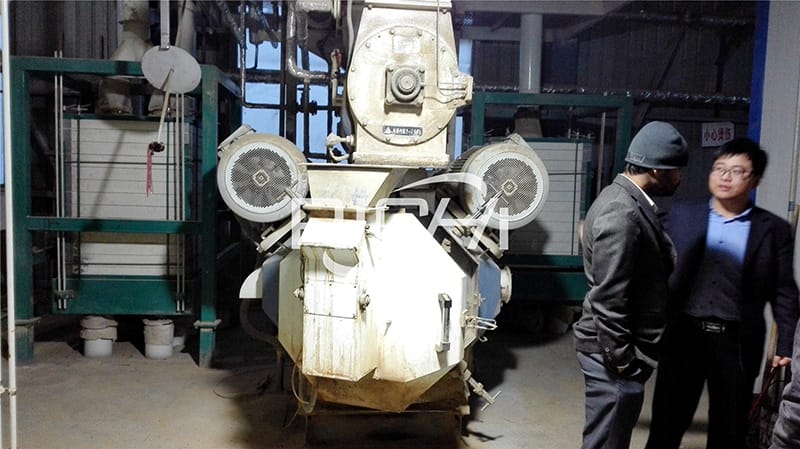China professional factory offered 300-400 kg/h turn-key floating fish feed pellet and pet food production line machinery for sale
With the rapid development of the aquaculture industry, traditional breeding methods are far from meeting people's needs. The requirements for aquatic feed are not only balanced nutrition, good feed stability in the water, etc., but also the environment in which animals live—— The quality of the water body puts forward stricter requirements. The production process of aquatic extruded feed is very different from the traditional production process of livestock poultry feed. According to the characteristics of aquatic feed with many varieties, large changes in raw materials, high requirements for crushing fineness and poor fluidity of materials, the production process is generally used Secondary crushing and mixing of secondary ingredients, and then through expansion, drying, external spraying, cooling, crushing and screening to complete the processing of aquatic puffed feed.
The 300-400 KG/H floating fish feed pellet and pet food making plant we are going to talk about today can not only produce fish feed, but also pet feed, because the core of this production line is an animal food extruder machine.

1.Floating fish feed and pet food manufacturing process of 300-400kg/h feed line
(1) Cleaning of raw materials and a coarse crushing
The raw materials used in feed mills generally have two forms: one is powdered materials, and they do not need to be coarsely crushed. This kind of raw material can be directly passed through the lowering pit and hoist, then enter the cone cleaning screen for impurity removal, and then undergo magnetic separation, and directly enter the batching bin through the distributor or screw auger to participate in the first batching; the other is The material that needs to be coarsely crushed-pellets. After this material enters the cleaning equipment through the lowering pit and elevator for magnetic separation, it enters the warehouse to be crushed, and then after coarse crushing by the fish feed hammer mill, it enters the batching warehouse through the lifter and distributor to participate in the first batching.
For individual raw materials, such as shrimp shells, it is not necessary to go through the initial cleaning and sieve, but directly enter the smashing warehouse after magnetic separation. Primary coarse pulverization is the pretreatment process of ultrafine pulverization in aquatic feed processing. Its main purpose is to reduce the particle size difference and variation range of materials, improve the working condition of the ultrafine grinder for fish feed, and increase the working efficiency and guarantee of the ultrafine grinder Product quality is stable; at the same time, in order to improve the working environment of workers and reduce cross-contamination, it is recommended to use an independent dust removal air network, that is, an independent dust removal system at the feeding port.
(2) The first batching and mixing
The first batch of ingredients is mainly the preparation of popular raw materials, that is, the preparation of relatively large materials in the formula. This process is mainly completed by the electronic batching scale. However, in the first batching process, special attention should be paid to the arching of the batching bin. This is mainly caused by the light bulk density of the raw materials of aquatic feed, especially high-grade aquatic feed materials, and the poor fluidity of the materials. Therefore, Certain anti-arching measures should be taken for the batching bin, such as eccentric discharge, vibration motor, etc. The single-shaft horizontal ribbon mixer can be used for the first mixing, and the grease addition system must be considered on the floating fish feed mixing machine. The first batching and mixing is also the pre-treatment process of ultra-fine pulverization. It is mainly to reduce the variation range of material particle size, improve the working condition of the pulverizer and increase the working efficiency of the pulverizer, and ensure the quality of the product.
(3) Secondary crushing and mixing of secondary ingredients
Due to the low food intake of aquatic animals, short digestive tract, and poor digestion capacity, aquatic feed requires a very fine particle size to increase the surface area of the feed, increase the contact area between the digestive juice of aquatic animals and the feed, and increase the feed of aquatic animals. At the same time, due to the low intake of aquatic animals, the mixing uniformity of the feed is required to be reflected in a smaller range, which also requires the aquatic feed to have a finer particle size. For example, all the shrimp feed must pass the 40-mesh analytical sieve, and the 60-mesh sieve must be less than 5%, so the micro-grinding process must be used.
In the secondary pulverization process, the mixed materials are lifted by a hoist and then enter the warehouse to be pulverized, and then enter the micro pulverizer. Micro pulverizers are generally used in the processing of aquatic feed, and are equipped with powerful air separation equipment, and then enter the rotary grading sieve for screening. The purpose of configuring the rotary grading screen here is mainly to remove the fine fluff formed by the coarse fiber in the feed during the crushing process, because the existence of these fine fluffs can easily adhere to the die holes of the extruder until the die holes are blocked, causing Shutdown cleaning, so it must be removed.
The cleaned materials undergo secondary batching and mixing. Because the fineness of the materials entering the secondary batching mixing bin is above 60 mesh and the density is small, special attention should be paid to arching. In order to prevent this phenomenon, on the one hand, the eccentric hopper can be used to expand the hopper, and on the other hand, all the superfinely pulverized material discharge machines adopt impeller feeders. It is not only equipped with an arch breaking mechanism, but also can flexibly adjust the flow rate. size. Various raw materials enter the secondary mixer after secondary batching. There is an artificial feeding port above the secondary mixer, which is mainly used for the addition of trace additives. At the same time, there is a liquid addition mechanism on the mixer for the addition of grease; one is for the addition of water. In the secondary mixing process, various materials must be fully mixed, and the coefficient of variation CV is less than 7%. This is the key to ensuring product quality. Therefore, the mixer must use a model with excellent performance, such as double-shaft horizontal blade mixing. The machine has high mixing uniformity, high output and fast mixing speed. After the material is pulverized and mixed with the secondary ingredients, it enters the subsequent process-puffing and pelletizing process.

(4) Puffing granulation process
In the extrusion process, the material actually goes through a cooking process under high temperature, high humidity and high pressure. In this process, the physical and chemical properties of the material change strongly, and the moment the material is extruded from the die hole, because the pressure suddenly drops from high pressure to about 100kPa, the water in the feed is immediately transformed from liquid to gas and is emitted from the feed. So that the material is expanded to form the so-called extruded feed. Because this kind of feed not only has the advantages of general hard pellet feed-good palatability, avoids automatic classification of products, is convenient for transportation, helps digestion, reduces waste in the feeding process, etc., but also has unique advantages: The starch has a high degree of gelatinization, and the protein is more digestible, which improves the utilization rate of feed for animals; it has excellent floatability, which is convenient for observing the feeding situation of fish and can control water pollution to the greatest extent. These are also the main reasons why extruded feed is widely used.
(5)Coating and Cooling
After the material is extruded by the fish feed extruder, it will form squishy particles (with a moisture content of 25% to 30%). At this time, it is best to use pneumatic conveying instead of using a hoist to lift. Because the use of elevator to lift can easily cause the crushing of particles and increase the pulverization rate; the use of pneumatic conveying can not only quickly form a layer of glue on the surface of the particles, reduce the fragmentation of the particles, but also round the shape of the particles . Due to the high moisture content of the materials conveyed by pneumatic force, they must enter the dryer for drying to reduce the moisture of the materials to about 13%. There are many kinds of dryers. I believe that when the diameter of the particles is less than 4mm, a vibrating fluidized bed dryer can be used; when the diameter of the particles is greater than 4mm, a belt dryer can be selected, or a horizontal float drying method can be used directly. machine.
Because this kind of dryer can make the material in a semi-suspended state on the entire screen surface, it can not only ensure the drying effect, but also minimize the damage to the particles. After the materials are dried, they enter the external spraying system. The external spraying of particles is mainly to meet the energy requirements of fish and reduce the loss of heat-sensitive substances during processing. Nutrients that should not be added in the previous process can be supplemented by spraying, and at the same time it can improve the palatability of the feed and reduce the powder content. The best working temperature for this process is around 80°C. After the material passes through the external spraying system, it can enter the countercurrent cooler for cooling.
(6) Finished product processing and packaging
The cooled fish feed pellet or pet food is lifted by a hoist and then crushed into the plane rotary screen for classification. The grading sieve is generally a two-layer sieve, and the material on the lower sieve is the finished product, which can be directly entered into the finished product warehouse, and then weighed and packaged. The material on the upper screen needs to be returned to the crusher for crushing. The material under the lower sieve is generally finely crushed material, which can be returned to the batching bin as waste material.

2.Main machines list of 300-400kg/h floating fish feed and pet food processing line for making fish feed
(1)Fish feed crusher(11kw)
Direct driving type with hammers, complete set, including the draft fan and cyclone; Equipped wih sceen, to crush to fine powder.
(2)Horizontal animal feed mixer(4kw)
Mixing uniformity is 97.7%, Lower Maintenance Cost, the mixing silo is made of Stainless steel.
(3)Feed extruder machine for floating fish and pet food (38.4kw)
Can be used to make all sizes floating fish feed pellets and pet dog cat food.
(4)Mesh typ drying machine(19.87kw)
Mesh belt type dryer, electricity type;The mesh belt is made by stainless steel;Final pellets through feeding device, evenly spread on the mesh belt; then with the the belt uniform rotation , the pellets fall from the first layer to the second layer then to bottom.
(5)Cooling machine(3kw)
The cooling aer and reverse motion of grain marerials ensures the gradual cooling of materials upwards,and aetter cooling result than other products.
(6)Packing machine
(7)Delivery system
Used to deliver the powder materials from the crusher to the mixer;
Used to deliver the final pellets from the extruder to the drying machine;
Used to deliver the final pellets from the dying machine to cooling machine.
Cost of 300-400kg/h floating fish and pet feed mill plant is around 40000-50000USD.
The above shows are 300-400kg/h feed pellet manufacturing line prodctioon process and 300-400kg/h turn-key floating fish feed feed production line machinery. This is the conventional configuration of the current aquatic extruded feed processing technology. With this process, it can be produced Sink fish feed, floating feed, pet feed. Although the extruded feed processing technology has been recognized by many manufacturers as a new type of processing technology, its investment amount is higher than that of pellet feed processing technology, so it has not been widely used at present. Nevertheless, the expansion process is the future development trend of the feed processing industry, especially in the application of aquatic animal feed and pet feed.
If you are looking 300-400kg/h floating fish feed processing line plant, 300-400kg/h dog food processing line, 300-400kg/h pet food line production equipments, etc. Welcome to contact Richi Machinery.
If you want to built one complete pellet production line in your country, pls send the inquiry to us. We will customized design according to your requirement.



